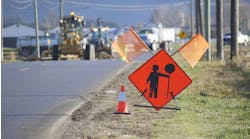Though the pandemic has slowed down many aspects of life, recent roadway safety statistics show that the dangers of working in highway work zones continue to rise. Now more than ever, training is of the utmost importance to mitigate risk for workers and road users.
Early data from the U.S. Department of Transportation (USDOT) National Highway Traffic Safety Administration (NHTSA) shows that reduced traffic didn’t help to stem the tide of roadway fatalities in 2020. In fact, 38,680 people died in traffic crashes, which is an increase of about 7.2 percent from 2019 and the largest number of fatalities in 13 years. The NHTSA report indicates that every region of the country showed an increase in estimated fatalities from 2019 to 2020.
With reduced traffic on the roads, why was this increase in fatalities still recorded? After examining driver behavior, NHTSA found three key issues in 2020 crashes: unrestrained occupants increased 15 percent, speeding-related crashes increased 11 percent, and police-reported alcohol involvement increased 9 percent.
Along with the risks to the motoring public, these issues pose a risk to roadway workers across the country. In their 2021 Work Zone Awareness Survey of 292 highway contractors, Associated General Contractors of America (AGC) and HCSS Software Solutions found that six out of 10 contractors reported at least one motor vehicle collision in their work zone in 2020.
In light of these challenges, proper training is especially important for contractors to stay safe on the job. Donna Clark, ATSSA vice president of education and technical services, said training helps workers prepare for the unexpected.
“There are many ’what-ifs‘ in a work zone. Training gives the worker the core skills they need to react appropriately and safely for the driver and those operating the work site,” she said.
Rick Brockman, East Coast Safety Officer at TRP Construction Group and ATSSA Master Instructor said training is more important than ever given the dangerous conditions and an influx of workers who are new to this type of work. With good training, workers gain the knowledge they need and build confidence in their capabilities.
“Training is an excellent retention tool. When employees are trained well, they feel they have value and when training is continuous, employees feel challenged and more likely to want to stay with the company because they continue to learn and grow,” Brockman said.
Early in the pandemic, ATSSA pivoted to meet training and certification needs by offering virtual training courses. Clark said now that people are seeking in-person training again, the organization is offering compliant, social-distanced instruction along with continued virtual training courses.
In addition to offering training, ATSSA is tackling roadway safety with its Roadway Worker Protection Council, established earlier this year. The council’s main focus areas are mitigating risk in work zones and creating a support plan to be ready when incidents occur.
Doug Dolinar, president of LimnTech Scientific and Roadway Worker Protection Council chair, said his involvement in the creation of the council was motivated by the loss of one of his workers in a 2020 drunk driving incident. Many other members of the council have similar personal reasons for joining and a desire to create real change.
“There needs to be a paradigm shift,” he said. “We should not be sending people out to work in environments where they may not come home. We can do better than that.”
Dolinar said with the alarming increases in distracted and drunk driving, the industry needs to shift its thinking to find solutions that will protect workers when safety devices fail.
In the face of ongoing traffic safety concerns, ATSSA members are committed to going above and beyond to work Toward Zero Deaths.
“It comes down to the people on the road,” Brockman said. “At the end of the day, they’re the ones out there working for all of us, trying to make the roads safer for the traveling public, working for the companies that put down a good product. We have to give them our respect and our time.”
For more information on joining these efforts or to find certified training, visit ATSSA.com.



